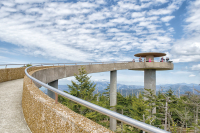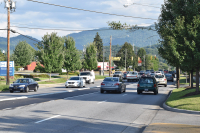Open-space in Jackson attracts attention
Jackson County’s planning board will continue weighing proposed changes to open-space regulations for a few more weeks before passing them on to commissioners for their thumbs up or thumbs down.
Jackson County is one of the few mountain counties with an open space rule, which requires developers to set aside a portion of new subdivisions as green space, natural areas and recreation. The open space rule has been in place for four years, but is being revisited for possible changes.
The planning board recently held a public hearing on the proposed changes. Members chose to hold off on a final decision about passing their recommendations along to county commissioners, who would have final say.
Planning Board Chairman Zachary Koenig and other board members, in delaying a vote, agreed they wanted time to consider what speakers had discussed and asked during the hearing.
The main concern expressed? Fear that the changes would hurt groundwater recharge. When the original open space rule was ushered in four years ago, along with a host of other steep slope and development regulations, groundwater recharge was central to the debate. Open space allowed rain water falling on the mountains to soak back into the soil and recharge the groundwater so many rely on for wells.
Some who spoke at the public hearing feared weaker open space requirements would negate what the previous board tried to accomplish.
Related Items
Board members denied diluting the rules, however, saying they in fact consider the issue so critical they removed it from the open-space regulations to ensure separate consideration of the matter during the next few months. Multi-family and commercial development also will be addressed in these future groundwater recharge standards. The current open space standards address single-family residential development.
“That will be our next task as a board,” Koenig promised speakers. “We think highly enough of water recharge to put together an entirely new ordinance.”
A couple of speakers seemed unpersuaded by the planning board’s decision.
“I must say I’m a little taken aback at the idea of erosion, water recharge have essentially been pulled out of the open space” discussion, said former developer John Beckman, who works as a farmer these days in Jackson County. “How can you not discuss hydrology, and the impacts that would have on the environment? It is not like open space is totally distinct and different from water-related issues.”
Roger Clapp, executive director of the Watershed Association of the Tuckasegee River, noted “on balance” the proposed changes “appears as a net positive for developers and a notable benefit for the environment and the future homeowners in news developments.”
Clapp did urge the planning board to set the document aside for a bit, as it did, though he requested “the issue of recharge … be addressed.”
The conservationist argued that the document turned the universally accepted definition of open space “on its ear. It never means built-up recreational areas such as tennis and basketball courts and golf courses, in my experiences.”
The changes include continuing to allow certain “hardscaping,” such as tennis courts, sidewalks and swimming pools, to count as open space in efforts to gain recreational space for the county’s residents, as the current ordinance does.
County Planner Gerald Green disagreed with Clapp, saying that including recreational space as “open space” is standard in planning circles. Planning board members also defended the use of recreational space.
Commissioner Doug Cody and Chairman Jack Debnam both attended the hearing. Cody said he hopes that residents “don’t have preconceived notions about what these revisiting of the ordinances are … I’m bothered that people think we are trying to destroy something. We’re not. We are trying to reach a balance.”
Other changes include:
• Currently, for subdivisions of eight or more lots, 25 percent of land must be placed in open space. Conservation design subdivisions open-space requirement would go to 20 percent open space of the land area. Green said that remains higher than in other counties. Twenty-five percent, he said before the hearing, in his opinion “increases the costs of homes for people who work and want to live here and does not effectively address the goals that have been identified by the county, which include promoting sustainable development.”
• Developers can opt now to pay a fee in lieu of providing open space. This fee would go to the Jackson County Recreation and Parks Department to help fund activities and spaces for residents. Developers also could offer other land for open space.
Groundwater recharge
Recharge is the process by which groundwater is replenished, and a recharge area is where water from precipitation moves downward to an aquifer. Groundwater is recharged naturally by rain and snow and by creeks, rivers and lakes. Recharge can be hampered by construction or other human activities such as logging.









